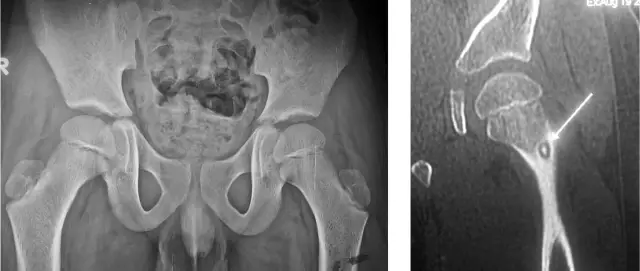- Author Rachel Wainwright [email protected].
- Public 2023-12-15 07:39.
- Last modified 2025-11-02 20:14.
Metatarsal bone
The metatarsus is the part of the foot between the tarsal bone and the phalanges of the toes. The metatarsus is formed by five tubular bones.

Metatarsal structure
Each metatarsal bone has a wedge-shaped base, body, and head. The second metatarsal bone is the longest, and the first is the most massive and shortest. The first metatarsal bone divides into two sites. Sesamoid bones adjoin both platforms of the metatarsal bone. The structure of the metatarsal bones is similar to the structure of the metacarpal bones, however, the heads of the metatarsal bones are compressed from the sides and narrowed.
The body of each metatarsal bone has three faces, and between the faces there are free spaces - interosseous spaces. With their articular surface, the bones of the metatarsus are connected to the bones of the tarsus.
In the fifth metatarsal bone, the articular facet is located only on one side of it (medial). The fifth metatarsal bone is slightly bumpy. The tendon of the peroneus short muscle is attached to the tuberous part of the fifth bone.
The base of the first metatarsal bone forms a joint with the medial sphenoid bone. The bases of the second and third bones of the metatarsus are connected to the lateral bone and to the sphenoid bones. The fifth bone is connected to the cuboid bone.
The metatarsal bones form longitudinal and transverse vaults with the tarsal bones, their convexity facing upwards. The metatarsal arch is located in the area of the metatarsal heads, and the tarsal arch is located in the area of the tarsal bones.
The arches of the foot perform a shock-absorbing function when walking and during static loads, as well as prevent tissue damage and create conditions for normal blood flow.
Metatarsal head displacement
The proximal phalanges of the fingers and the heads of the metatarsal bones form the metatarsophalangeal joints. The articular capsule of the bone consists of the outer layer, represented by dense fibrous tissue, and the inner layer, formed by the synovial membrane.
The displacement of the head of the metatarsal bones leads to inflammation and further damage to the joint, the development of capsulitis and synovitis. The enlarged head of the metatarsal bones is covered with calloused skin. Joint pain is the main symptom of displacement of the metatarsal head.
Treatment is selected taking into account the degree of deformation of the metatarsal head. With the initial manifestations of deformation, it is possible to use orthopedic devices (insoles, interdigital pads, instep supports).
The reconstructive method of surgical intervention can eliminate flat feet and valgus of the first toe. Under local anesthesia, the first bone of the metatarsus is fixed with metal wires in the correct position (corrective osteotomy), resection (removal) of the deformed head of the metatarsal bone (“bumps”). After surgery, instep supports are attached to the patient's foot.
Metatarsal fracture
Metatarsal fractures are both traumatic and stressful (fatigue). A traumatic fracture (without displacement or with displacement) can occur as a result of foot tucking or a direct impact. With a fracture of the metatarsal bone without displacement, the fragments of the bones retain the correct position. With a fracture with displacement, there is a violation of the anatomical position of the fragments.
A traumatic fracture of the metatarsal bone manifests itself in a characteristic crunch during injury, pain in the fracture area, shortening of the toe or deviating it to the side. Bruising or swelling may appear in the area of the fracture.
Jones fracture is a type of metatarsal fracture. This fracture occurs at the base of the fifth metatarsal bone and is characterized by nonunion or delayed union. One of the varieties of metatarsal fractures is the Jones fracture. Sprains are often misdiagnosed with a Jones fracture.
Fatigue fracture of the bones of the metatarsus - imperceptible cracks arising from deformation of the foot, osteoporosis, pathological bone structure, prolonged repeated stress.
With a fatigue fracture of the metatarsal bone, pain occurs after or during exercise, pain in the fracture area when touched, and edema.
In the absence of treatment, or with improper treatment of a fracture of the bones of the metatarsus, complications can develop - arthrosis, deformities, non-union of the fracture, chronic pain in the foot.
Fracture treatment depends on its location, nature, and the presence of displacement. The following methods are used to treat metatarsal fractures:
- Plaster immobilization - used for fracture of the metatarsal bones without displacement;
- Surgical intervention.
In case of a fracture with displacement, bone fragments are compared, and then fixed with implants.
Found a mistake in the text? Select it and press Ctrl + Enter.






